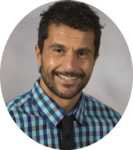WANT TO BE A NEW CHAPTER ALUMNI?
Apply online to share your accomplishments and endeavors.
APPLY TO BE FEATUREDJanuary 2026

Jackson, Mississippi
Professor, Departments of Physiology and Biophysics, Medicine and Radiology
University of Mississippi Medical Center
VIEW PROFILEAt the end of his clinical training in cardiology in his native Argentina, Alejandro Chade, M.D. (HYT ’03), went to Mayo Clinic in Rochester for a few months to learn echocardiography. He was tempted to return to Mayo for a yearlong research fellowship and seized the opportunity. That decision changed the course of his career. He gave up clinical practice for an academic research career — now studying therapeutic strategies for renovascular disease and chronic kidney disease at the University of Mississippi.
In the last year of my cardiology fellowship in Argentina, I was accepted at Mayo Clinic for a three-month visiting rotation in the echocardiography lab. I planned to learn echo skills, return to Argentina and finish my clinical training. At Mayo, I was offered to participate in a small research project, which I enjoyed. On my last day, I was offered a research fellowship by the person who would become my mentor, Lilach Lerman, M.D., Ph.D. (PHYS ’91, PHYS ’95).
I returned to Argentina, moved up the date for my wedding, and got married before moving to Rochester for what I thought would be one year of basic research in animal models and high-resolution CT imaging of kidneys. I really liked it, so I applied for grants and ended up staying at Mayo for six years.
Mendoza is the fourth-largest city in Argentina, with universities, a vibrant culture and a busy nightlife. Rochester was more like living in a small town, but everyone was friendly and pleasant. We had a very happy life in Rochester. At the beginning, the weather was a shock. To treat ourselves, we would go to Minneapolis or explore Minnesota. Our son was born in Rochester. We want to take him back to show him where he was born.
Mayo Clinic is impressive and a wonderful place to work. It’s vast, but all the components work together nicely all the time. Everything is integrated and done for you so you can study, focus on research and expand your knowledge.
Mayo Clinic was the turning point in my career. I had planned to be a clinical cardiologist. Instead, I’m a full tenured professor with my own research program. I owe my research career to Mayo. Research and teaching are my passions.
At Mayo, I received the Edward C. Kendall Award for Meritorious Research from the Mayo Clinic Alumni Association, which was the first major recognition of my research. Having research recognized at Mayo made me really proud.
Today, when I talk to people at international and national meetings and mention having trained at Mayo Clinic, they perk up, pay more attention, and ask if I know this or that person. Sometimes they comment on the weather. They ask very specific questions. How was working and doing research there? Was it easy to perform experiments? Did you have the facilities to do what you wanted? Would you recommend training there? Having Mayo Clinic on your CV is a badge of honor and conversation starter.
In my last year at Mayo Clinic, the chair of the Department of Physiology at the University of Mississippi Medical Center visited Mayo Clinic to give some talks. I shared my research project with him, and he recruited me as an assistant professor. I wasn’t familiar with the southern U.S., but it’s been a wonderful adventure. We are a happy family of four now. (My daughter was born in Mississippi.)
Eighty percent of my time is devoted to research of new treatments to protect the kidneys. I use a novel swine model of renovascular disease, and I am developing a new model of chronic kidney disease that develops much like human disease. I study the effects of disease and responses to treatments using fast CT to noninvasively characterize in vivo renal regional volume, total renal blood flow, glomerular filtration rate, tubular fluid dynamics and endothelial function in combination with micro-CT imaging to reconstruct the 3-D architecture of the renal microcirculation. My lab is one of only two in the world using this approach.
I am associate director of the Ph.D. in Physiology program, and I teach master’s students, Ph.D.’s, and dental and medical students. I have a full academic life.
Some people wonder why I gave up clinical practice and half of the possible income for a research career that’s dependent on external funding. The simple answer is that I worked hard to find something I really love.
She’s still my mentor and source of advice. I communicate with her almost every week. She had all the patience in the world to train me to be the best I could be. She was generous in sharing what she knew. She communicated that, “Your success is my success — I see your passion and want you to be the best you can be.” The more I worked, the more she trusted me and trained me. I was a research fellow in her lab, but she treated me like someone from her family. Her approach to mentoring imprinted on me, and now I train my students that way.
I’m a very outdoorsy person. I like soccer. I work out on a regular basis and enjoy mountain biking, too. I do a lot of activities with my kids, ages 12 and 8, to expose them to a healthy lifestyle. We like exploring Mississippi. I play drums. I started in my teens and recently started playing again. I also am a home brewer.
See past New Chapter stories here.
Apply online to share your accomplishments and endeavors.
APPLY TO BE FEATURED